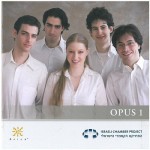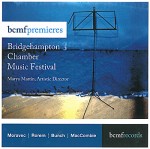Column Name
Title
Opus 1: Music of Saint-Saëns, Martinu, Porat, Debussy, and Bartok. Israeli Chamber Project. (Azica Records, ACD-71274)
Body
This intelligent program (which was beautifully recorded by Bruce Egre in the recital halls at Queens College and Purchase College) boasts some outstanding playing by the award-winning Israeli Chamber Project. Founded in 2008, the group includes five Juilliard alumni: clarinetist Tibi Cziger, cellist Michal Korman, harpist Sivan Magen, violinist Itamar Zorman, and pianist Assaff Weisman, who teaches in the Evening Division. Shmuel Katz, who studied with alumnus Pinchas Zukerman and Juilliard faculty member Michael Tree, is the ensemble’s violist.
A highlight is Martinu’s lighter-than-air Chamber Music No. 1 (1959, for six musicians), one of his last works. Its three movements are a model of deft craftsmanship, fusing delicacy and intensity. A sprightly, folk-drenched Allegro moderato leads to a slow, magical Andante and a joyful Poco allegro, all played by the sextet with exuberance and zest.
Zorman’s violin soars when he teams up with Magen for Saint-Saëns’s Fantaisie for Violin and Harp (1893), with Magen adding a touch of flamenco guitar to his harp in the fandango-tinged closing pages. Substituting harp for the piano part, Magen has given Debussy’s Sonata for Cello and Piano a remarkable arrangement. It’s so persuasive that some listeners may have difficulty recalling the original, and helped in no small measure by the fleet touches of Magen and cellist Korman.
Matan Porat’s Night Horses, commissioned for the ensemble, derives its title from Jorge Luis Borges, who felt the original meaning of “nightmare” refers to a black horse some people encounter in bad dreams. Using the same instrumentation as Messiaen’s Quatuor pour la fin du temps (clarinet, violin, cello, and piano; 1941), Porat creates a dreamlike rhapsody built on Weisman’s gentle piano murmurings in the opening. The program closes with Bartok’s Contrasts (clarinet, violin, and piano; 1938), featuring some precise clarinet work from Cziger, especially in the jazzy cadenza that closes the first movement, “Verbunkos.” Zorman soars in the final movement, “Sebes,” with Weisman’s spirited keyboard work tying the three together.
New Yorkers can hear the ensemble live on December 13 at Merkin Concert Hall, where it will perform works by Brahms, Bruch, and Sergiu Natra—along with Magen’s Debussy arrangement.
BCMF Premieres. Bridgehampton Chamber Music Festival; Marya Martin, Artistic Director (BCMF Records)
An enigmatic bassoon solo from Peter Kolkay ignites Paul Moravec’s Wind Quintet (2010), which begins this first release from the Bridgehampton Chamber Music Festival, featuring four works the festival has premiered. Kolkay is soon joined by flutist Marya Martin (Bridgehampton’s artistic director), oboist John Snow, clarinetist Jose Franch-Ballester, and hornist Stewart Rose. Moravec’s suite contains seven short pieces—one marked “Lively” is just 40 seconds long—and they’re all given rapt attention. The finale, marked “Quick” and anchored by Martin’s jaunty flute and Snow’s tautly controlled oboe, sounds like a loquacious duck making a beeline to the water.
Written for the festival, and for the same instrumentation as the Moravec, Kenji Bunch’s Changes of Phase (1999) takes its name from a high-school chemistry term. Bunch, who studied viola at Juilliard with Toby Appel and composition with Robert Beaser and is on the Pre-College faculty, has written a strong set with a Copland-esque third movement and a rhythmically catchy finale.
Charles Ives’s iconic The Unanswered Question inspired the title of Ned Rorem’s The Unquestioned Answer (2002), in which a quartet of flute, violins, and cello offers a warm, sentimental first half, followed by a more animated section, with pianist Orion Weiss (B.M. ’04) darting around the keyboard. Violinists Jesse Mills (B.M. ’01) and Yura Lee (Pre-College ’01) join cello faculty member Fred Sherry (Diploma, ’65) in Rorem’s sensitively conceived string parts.
The program closes with Light Upon the Turning Leaf (2010), a gently mournful septet by Bruce MacCombie, who died last May, and served as Juilliard’s dean from 1986 to 1992. Carefully placed piano chords from Shai Wosner (B.M. ’99, M.M. ’01) anchor a haze of strings and winds inspired (according to the composer) by music, poetry, and meditation. Martin joins violinist Stefan Jackiw, violist Beth Guterman (B.M. ’03, M.M. ’05), bassoonist Seth Baer (M.M. ’05), and faculty members clarinetist Anthony McGill and cellist Edward Arron (B.M. ’98).
Adam Abeshouse did the lion’s share of recording honors at Bridgehampton Presbyterian Church, creating a “you are there” feeling. And for MacCombie’s elegy—from a separate live performance—engineer Leszek Wojcik captured the music’s translucence.






